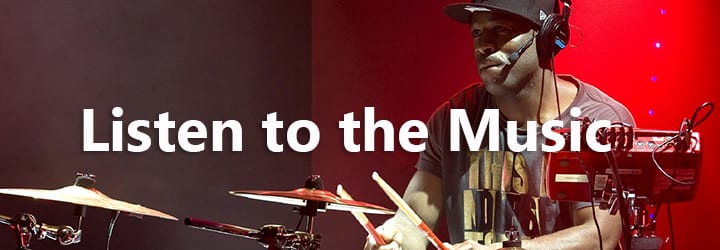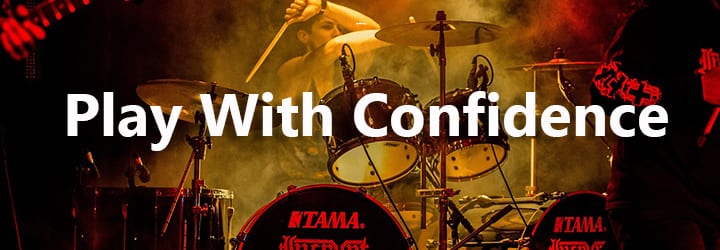Whether you’re a beginner or an intermediate drummer, you may have aspirations to perform or play with a band. Here, Edmond, OK drum instructor Tracy D. shares five important steps to help you take your drumming skills to the next level…
It’s no secret that playing drums can be one of the most exhilarating experiences you can have on stage. You can feel the power of your rhythms and see your audience rocking out along with you.
But how do you make sure that your next drum performance is the best it can possibly be? Here are five steps to help you nail your next drum performance!
What Are the Best Drumming Performances?
Drumming is an art form that requires skill, agility and a lot of practice:
- When it comes to memorable drumming performances, some of the most iconic come from classic rock drummers like John Bonham and Keith Moon:
- Whether it’s Bonham’s thunderous beats on Led Zeppelin classics or Moon’s relentless energy for The Who, these great players made their mark with unforgettable performances.
- But there are also lots of modern drummers who deliver incredible live shows.
- Dennis Chambers, Mike Mangini and Thomas Lang all bring incredible showmanship to their solo breaks and fill sets, making for jaw dropping displays that astound audiences around the world.
All in all, a good drumming performance is one that demonstrates technical prowess and interacts with the music in interesting ways. No matter who is up on stage playing drums, it’s sure to be an electrifying experience!Want to learn how to play the drums like all of these legends – and deliver the best drum performances possible? You need to sign up for drum lessons as soon as possible. You’ll learn everything you need to know in order to nail your next live drum performance – plus tips like what you see in the video below:
https://www.youtube.com/watch?v=LwKF7LiXW3I
How to Nail Your Next Drum Solo Performance
Taking your drumming from the practice room to the stage requires a whole new set of skills. You have to learn to play in tandem with others to develop a certain sound and feel.
While playing drums on stage requires a lot of practice and experience, you can nail your next drum performance with these five tips…
Learning the music for a big band or ensemble is a bit different than learning music for a smaller pop or rock setup. In an ensemble, the sheet music is typically a chart. Look for ensemble figures (unison hits with the band), solos, and the main groove (which may or may not be notated).
Here’s an example of a chart used by an ensemble.
You typically have some creative license with time. Sit with your music and listen to the recording. Make notes about form and instrumentation (auxiliary percussion), if needed.
If you play with a smaller band, there should be a lead sheet (lyrics and chords; usually not notated). Below is a picture of what that looks like. 
It’s pretty simple to chart your moves because you already have the form and vocal cues. Listen to your tune and make notes about the intro, fills, section lengths, breaks (count), and changes in groove or meter.
Take the time to simply listen to the music. Absorb the rhythmic feel and emotion. This step will also help fuel your creativity.
After you’ve listened to the music a few times through, play along with the track and make more notes. You can further this practice by drumming along with your favorite songs.
The stage isn’t the place to try that new crazy fill you’ve been working on. Perfect your new ideas in practice — your band will thank you.
If you do want to work on some cool new fills (in practice of course), try these three simple steps.
The beat is the backbone of the band, and with a bit of focus, you can own it.
Confidence comes from practice and preparation, so do your homework before your drum performance.
Watch your band or band director for cues, especially for solos, breaks (count), and rubato passages. Make sure your intros and outros are tight.
Enjoy making music! You’ve done the technical prep work, so concentrate on creating an awesome feel with your fellow musicians.
What Techniques Are Used in Drumming?
Whether you’re a beginner or a pro, live performances can be nerve-wracking. You want to make sure you sound your best, and that means practicing the right techniques. So what are those techniques? We’ll cover some of the basics here so you can take your performance up a notch!
Breath Control and Expression
One of the most important aspects of drumming is breath control. How you breathe while playing affects how your sound comes across in a live setting. A good way to practice this is to use vocal exercises or tongue twisters like “red leather, yellow leather”.
This will help you become comfortable with using air flow and pressure when hitting the drums. Breath control also helps with expression when playing. It allows for more dynamic articulation during solos and fills and makes it easier to create crescendos and decrescendos as needed.
Posture
Another key factor in improving your live performances is posture. The position of your body affects how well you play by helping you move around the drums easily, which in turn leads to better dynamics and accuracy.
Make sure that your torso is straight but relaxed, shoulders are open, arms are slightly bent at the elbows, wrists are free-moving but not tense, feet should be balanced on both sides of the bass drum pedal for stability, and lastly head should be up with neck slightly bent forward. All these small adjustments help create muscle memory for certain motions so that they become natural when performing on stage.
Listening
The last technique we’ll mention is listening—and we don’t mean just listening to yourself! Listening involves hearing other people’s music on recordings or even live performances if possible so that you can learn from their style and pick up on any new ideas they may have used in their own music making process.
This will not only help improve your playing but also give you an idea of what kind of sounds or rhythms might appeal better in a certain context or setting depending on who is performing alongside you in a live show situation.
What is the Best Drum Kit for Live Performance?
Let’s be honest, drummers are the backbone of any live performance. You need a reliable and sturdy drum kit that can handle the rigors of any gig. But with so many options on the market, it can be hard to know which one is right for you. No worries though—we’ve got you covered!
Here’s a short guide to choosing the best drum kit for live performance.
Staying in Tune
One of the most important factors when selecting a drum kit is its ability to stay in tune. Nothing ruins a performance quicker than having drums that continually go out of tune. Look for drums that have durable components like stainless steel and titanium hardware, as well as strong tension rods. This will ensure that your drums don’t go out of tune in between songs or even during them!
Durability
Another key factor to consider when purchasing a drum kit is its durability. You want something that will last through countless gigs and practices without needing repairs or maintenance. To find this type of quality, look for drums with thick shells made from wood such as maple or birch. These materials are known for their durability and strength, and they also create great tones too!
Final Details
Finally, pay attention to details like finish, color, size, and accessories included with your purchase. While these might seem insignificant compared to other factors like sound and durability, they can make all the difference when performing live onstage. A bright finish can add an extra bit of flair while larger sizes provide more volume and projection capabilities.
Accessories such as cymbal stands and snare stands will help keep everything organized during performances too!
How to Mic Drums for Live Performance
Have you ever been to a live show and heard the drums sound like a tin can? Or worse, a mix so loud that it’s painful to listen to? If so, you know that proper drum mic-ing is crucial for an enjoyable performance. But what exactly does that entail? Let’s explore the art of properly mic-ing drums for a live performance.
What You Need To Mic Drums
Micing drums is not as complicated as some people may think. It simply requires the right tools. To start, you’ll need three types of mics: dynamic mics (like the Shure SM57), condenser mics (like the AKG C414) and boundary mics (like the Audio Technica AT4050). You will also need mic stands and cables, plus an audio interface or mixer if you want to record your performance—and of course, your drums!
Position Your Mics
Now that you have all your tools in place, let’s talk about how to position them around your drum set. The most important thing is to experiment until you find what sounds best for your particular setup.
Start by placing two dynamic mics on either side of your kick drum pointing towards its beater head. Place one condenser mic above the snare angled down slightly towards it, and another above it angled up towards its rim. Then place one dynamic mic in front of each tom pointing towards its middle area.
Finally, use two boundary mics placed on either side of the entire kit in order to capture the “room” sound and provide overall balance between the other mics.
Adjust Settings On Your Mixer or Interface
Once your microphones are all in place, it’s time to adjust their settings on either your mixer or audio interface. Raise or lower each mic’s level until they are balanced with each other and with any backing tracks playing through onstage monitors or speakers.
This can take some time; just be patient and keep tweaking until everything sounds just right! Once that’s done, all that’s left is fine tuning any EQ settings necessary for getting a fuller sound from certain elements like cymbals or snares—but don’t overdo it because too much EQ can make things sound artificial!
Why is Drumming So Powerful?
Drumming is an ancient practice that has been used to connect mind, body, and soul through its rhythmic pulse. Its powerful vibrations help to quiet the mental chatter of everyday life while enhancing the flow of energy within individuals and across a group.
Drumming creates a strong sense of unity and belonging, which can be especially beneficial during times of collective trauma or hardship.
Besides being a great way to let off steam and relax, drumming also provides an imbued heightened state of awareness which can help with creative problem solving and spiritual journeying. In sum, drumming is a powerful tool for connection in both individual and collective contexts that continues to inspire transformation today.
Nailing a great drum performance may not be easy—but if you follow these five simple steps, then it’s definitely within reach!
With proper preparation and focus on quality, combined with some creativity and character, anyone can give an unforgettable live performance behind the drums. So grab your sticks (and maybe a costume too!) – because it’s showtime! Sign up for drum lessons if you’re not sure how to get started.
One more important tip: make sure you always warm-up for practice or a gig. Even after you learn these basic tips, it’s important to implement them at every performance. Not only will you and your band feel good about your performance, but your audience will enjoy it even more!
Not quite ready to take the stage? We can help you get there. Sign up for lessons with a private drum teacher today!
 Post Author: Tracy D.
Post Author: Tracy D.Tracy D. teaches percussion and drum lessons in Edmond, OK, as well as online. She has been playing the drums with various bands for more than 13 years. Tracy earned her Bachelor’s in Music Education from Oklahoma Christian University and has played with the OKC Community Orchestra since 2009. Learn more about Tracy here!
Photo by Thomas Hawk
Maile Proctor








